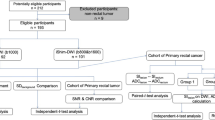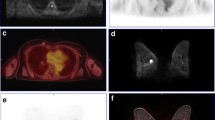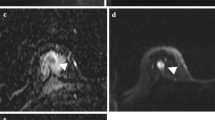Abstract
Purpose
To evaluate the feasibility of proposed integrated slice-by-slice shimming (iShim) for whole-body diffusion weighted imaging (WB-DWI) in comparison to conventional 3D shim in patients with breast cancer.
Materials and methods
Retrospective analysis of 116 consecutive patients (116 lesions) who underwent whole-body PET/MR using iShim (iShim group) were performed and compared with historical control of 103 patients (105 lesions) using 3D Shim (3D Shim group).
Results
As compared with dynamic contrast-enhanced (DCE) breast MRI, the apparent diffusion coefficient (ADC) value could not be determined for 15 (14%) of the 105 lesions of the 3D shim group and for 10 (9%) of the 116 lesions on iShim group. The intergroup difference failed to reach statistical significance (P = 0.1843). On the other hand, there was a significant difference in the frequencies of PET-positive and DWI-negative lesions between the 3D shim and iShim group (8.6% vs. 1.7%, respectively, P = 0.01942).
Conclusion
In regard to detectability of breast cancers by DWI, iShim may allow improved detectability as compared to conventional 3D shim.



Similar content being viewed by others
References
Zhang H, Xue H, Alto S, Hui L, Kannengiesser S, Berthold K, et al. Integrated shimming improves lesion detection in whole-body diffusion-weighted examinations of patients with plasma disorder at 3 T. Invest Radiol. 2016;51(5):297–305.
Bogner W, Pinker-Domenig K, Bickel H, Chmelik M, Weber M, Helbich TH, et al. Readout-segmented echo-planar imaging improves the diagnostic performance of diffusion-weighted MR breast examinations at 3.0 T. Radiology. 2012;263(1):64–76.
Chen N, Guidon A, Chang HC, Song AW. A robust multi-shot scan strategy for high-resolution diffusion weighted MRI enabled by multiplexed sensitivity-encoding (MUSE). Neuroimage. 2013;72(9):41–7.
Riffel P, Michaely HJ, Morelli JN, Pfeuffer J, Attenberger UI, Schoenberg SO, et al. Zoomed EPI-DWI of the head and neck with two-dimensional, spatially-selective radiofrequency excitation pulses. Eur Radiol. 2014;24(10):2507–12.
Thierfelder KM, Scherr MK, Notohamiprodjo M, Weiß J, Dietrich O, Mueller-Lisse UG, et al. Diffusion-weighted MRI of the prostate: advantages of zoomed EPI with parallel-transmit-accelerated 2D-selective excitation imaging. Eur Radiol. 2014;24(12):3233–41.
Lee SK, Tan ET, Govenkar A, Hancu I. Dynamic slice-dependent shim and center frequency update in 3 T breast diffusion weighted imaging. Magn Reson Med. 2014;71(5):1813–8.
Sasaki M, Tozaki M, Kubota K, Murakami W, Yotsumoto D, Sagara Y, et al. Simultaneous whole-body and breast 18F-FDG PET/MRI examinations in patients with breast cancer: a comparison of apparent diffusion coefficients and maximum standardized uptake values. Jpn J Radiol. 2018;36(2):122–33.
Martinez-Moller A, Souvatzoglou M, Delso G, Bundschuh RA, Chefd’hotel C, Ziegler SI, et al. Tissue classification as a potential approach for attenuation correction in whole-body PET/MRI: evaluation with PET/CT data. J Nucl Med. 2009;50(4):520–6.
Martinez-Moller A, Eiber M, Nekolla SG, Souvatzoglou M, Drzezga A, Ziegler S, et al. Workflow and scan protocol considerations for integrated whole-body PET/MRI in oncology. J Nucl Med. 2012;53(9):1415–26.
Choi BB, Kim SH, Kang BJ, Lee JH, Song BJ, Jeong SH, et al. Diffusion-weighted imaging and FDG PET/CT: predicting the prognoses with apparent diffusion coefficient values and maxi- mum standardized uptake values in patients with invasive ductal carcinoma. World J Surg Oncol. 2012;10(9):126.
American College of Radiology. Breast imaging reporting and data system: breast imaging atlas (BI-RADS). 5th ed. Reston Va: ACR; 2013.
Kanda Y. Investigation of the freely available easy-to-use software ‘EZR’ for medical statistics. Bone Marrow Transpl. 2013;48(3):452–8.
Author information
Authors and Affiliations
Corresponding author
Ethics declarations
Conflict of interest
Thomas Benkert and Katsuya Maruyama are employees of Siemens Healthcare, who provided crucial technical support with the MR sequence but were not involved in data acquisition and analysis. The authors declare that they have no conflict of interest.
Ethical approval
This retrospective study was conducted with the approval of our institutional review board. All the patients provided written informed consent for our review of their medical records and images.
About this article
Cite this article
Sasaki, M., Tozaki, M., Maruyama, K. et al. Does integrated shimming improve lesion detection in whole-body diffusion-weighted examinations of patients with breast cancer?. Jpn J Radiol 36, 736–743 (2018). https://doi.org/10.1007/s11604-018-0781-9
Received:
Accepted:
Published:
Issue Date:
DOI: https://doi.org/10.1007/s11604-018-0781-9




